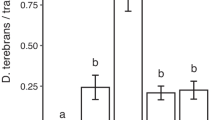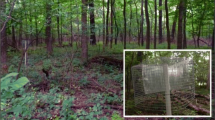Abstract
Orientation for insects in olfactory landscapes with high semiochemical diversity may be a challenging task. The partitioning of odor plumes into filaments that are interspersed with pockets of ‘clean air’ may help filament discrimination and upwind flight to attractive sources in the face of inhibitory signals. We studied the effect of distance between odor sources on trap catches of the beetle, Ips typographus, and the moth, Spodoptera littoralis. Insects were tested both to spatially separated pheromone components [cis-verbenol and 2-methyl-3-buten-2-ol for Ips; (Z,E)-9,11-tetradecadienyl acetate and (Z,E)-9,12-tetradecadienyl acetate for Spodoptera], and to separated pheromone and anti-attractant sources [non-host volatile (NHV) blend for Ips; (Z)-9-tetradecenyl acetate for Spodoptera]. Trap catch data were complemented with simulations of plume structure and plume overlap from two separated sources using a photo ionization detector and soap bubble generators. Trap catches of the beetle and the moth were both affected when odor sources in the respective traps were increasingly separated. However, this effect on trap catch occurred at smaller (roughly by an order of magnitude) odor source separation distances for the moth than for the beetle. This may reflect differences between the respective olfactory systems and central processing. For both species, the changes in trap catches in response to separation of pheromone components occurred at similar spacing distances as for separation of pheromone and anti-attractant sources. Overlap between two simulated plumes depended on distance between the two sources. In addition, the number of detected filaments and their concentration decreased with downwind distance. This implies that the response to separated odor sources in the two species might take place under different olfactory conditions. Deploying multiple sources of anti-attractant around a pheromone trap indicated long-distance (meter scale) effects of NHV on the beetle and a potential use for NHV in forest protection.






Similar content being viewed by others
References
Andersson, M. N., Larsson, M. C., Blaženec, M., Jakuš, R., Zhang, Q.-H., and Schlyter, F. 2010. Peripheral modulation of pheromone response by inhibitory host compound in a beetle. J. Exp. Biol. 213:3332–3339.
Baker, T. C., and Haynes, K. F. 1989. Field and laboratory electroantennographic measurements of pheromone plume structure correlated with oriental fruit moth behavior. Physiol. Entomol. 14:1–12.
Byers, J. A. 1987. Interactions of pheromone component odor plumes of western pine beetle. J. Chem. Ecol. 13:2143–2158.
Byers, J. A., Zhang, Q.-H., and Birgersson, G. 2000. Strategies of a bark beetle, Pityogenes bidentatus, in an olfactory landscape. Naturwissenschaften 87:503–507.
Campion, D. G., Hunter-Jones, P., Mcveigh, L. J., Hall, D. R., Lester, R., and Nesbitt, B. F. 1980. Modification of the attractiveness of the primary pheromone component of the Egyptian cotton leafworm, Spodoptera littoralis (Boisduval) (Lepidoptera: Noctuidae), by secondary pheromone components and related chemicals. Bull. Entomol. Res. 70:417–434.
Cardé, R. T., and Willis, M. A. 2008. Navigational strategies used by insects to find distant, wind-borne sources of odor. J. Chem. Ecol. 34:854–866.
Christensen, T. A., and Hildebrand, J. G. 1997. Coincident stimulation with pheromone components improves temporal pattern resolution in central olfactory neurons. J. Neurophysiol. 77:775–781.
Coracini, M., Bengtsson, M., Cichon, L., and Witzgall, P. 2003. Codling moth males do not discriminate between pheromone and a pheromone/antagonist blend during upwind flight. Naturwissenschaften 90:419–423.
David, C. T., Kennedy, J. S., and Ludlow, A. R. 1983. Finding of a sex pheromone source by gypsy moths released in the field. Nature 303:804–806.
Fadamiro, H. Y., Cossé, A. A., and Baker, T. C. 1999. Fine-scale resolution of closely spaced pheromone and antagonist filaments by flying male Helicoverpa zea. J. Comp. Physiol. A 185:131–141.
Galizia, C. G., and Rössler, W. 2010. Parallel olfactory systems in insects: Anatomy and function. Annu. Rev. Entomol. 55:399–420.
Gillette, N. E., Erbilgin, N., Webster, J. N., Pederson, L., Mori, S. R., Stein, J. D., Owen, D. R., Bischel, K. M., and Wood, D. L. 2009. Aerially applied verbenone-releasing laminated flakes protect Pinus contorta stands from attack by Dendroctonus ponderosae in California and Idaho. Forest Ecol. Manag. 257:1405–1412.
Hedges, L. V., and Olkin, I. 1985. Statistical Methods for Meta-analysis. Academic, Orlando.
Hoffmann, J. P. 2004. Generalized Linear Models: An Applied Approach. Pearson A and B, Boston.
Jactel, H., and Brockerhoff, E. G. 2007. Tree diversity reduces herbivory by forest insects. Ecol. Lett. 10:835–848.
Jactel, H., Birgersson, G., Andersson, S., and Schlyter, F. 2011. Non-host volatiles mediate associational resistance to the pine processionary moth. Oecologia. doi:10.1007/s00442-011-1918-z.
Jakuš, R., Schlyter, F., Zhang, Q.-H., Blaženec, M., Vavercák, R., Grodzki, W., Brutovský, D., Lajzová, E., Turcáni, M., Bengtsson, M., Blum, Z., and Gregoiré, J.-C. 2003. Overview of development of an anti-attractant based technology for spruce protection against Ips typographus: From past failures to future success. J. Pest Sci. 76:89–99.
Justus, K., Murlis, J., Jones, C., and Cardé, R. 2002. Measurement of odor-plume structure in a wind tunnel using a photoionization detector and a tracer gas. Environ. Fluid Mech. 2:115–142.
Kehat, M., Greenberg, S., and Tamaki, Y. 1976. Field evaluation of the synthetic sex pheromone as an attractant for males of the cotton leafworm Spodoptera littoralis in Israel. Appl. Entomol. Zool. 11:45–52.
Linn, C. E., Jr., and Gaston, L. K. 1981. Behavioral function of the components and the blend of the sex pheromone of the cabbage looper, Trichoplusia ni. Environ. Entomol. 10:751–755.
Liu, Y. B., and Haynes, K. F. 1992. Filamentous nature of pheromone plumes protects integrity of signal from background chemical noise in cabbage looper moth, Trichoplusia ni. J. Chem. Ecol. 18:299–307.
Ljungberg, H., Anderson, P., and Hansson, B. S. 1993. Physiology and morphology of pheromone-specific sensilla on the antennae of male and female Spodoptera littoralis (Lepidoptera: Noctuidae). J. Insect Physiol. 39:253–260.
Lux, S. A., Hassanali, A., Lwande, W., and Njogu, F. N. 1994. Proximity of release points of pheromone components as a factor confusing males of the spotted stem borer, Chilo partellus, approaching the trap. J. Chem. Ecol. 20:2065–2075.
Mafra-Neto, A., and Cardé, R. T. 1994. Fine-scale structure of pheromone plumes modulates upwind orientation of flying moths. Nature 369:142–144.
Miller, J. R., Gut, L. J., De Lame, F. M., and Stelinski, L. L. 2006. Differentiation of competitive vs. non-competitive mechanisms mediating disruption of moth sexual communication by point sources of sex pheromone (Part 1): Theory. J. Chem. Ecol. 32:2089–2114.
Minks, A. K., and Cardé, R. T. 1988. Disruption of pheromone communication in moths: is the natural blend really most efficacious? Entomol. Exp. Appl. 49:25–36.
Murlis, J., and Jones, C. D. 1981. Fine scale structure of odor plumes in relation to insect orientation to distant pheromone and other attractant sources. Physiol. Entomol. 6:71–86.
Murlis, J., Elkinton, J. S., and Cardé, R. T. 1992. Odor plumes and how insects use them. Annu. Rev. Entomol. 37:505–532.
Murlis, J., Willis, M. A., and Cardé, R. T. 2000. Spatial and temporal structures of pheromone plumes in fields and forests. Physiol. Entomol. 25:211–222.
Nakagawa, S., and Cuthill, I. C. 2007. Effect size, confidence interval and statistical significance: a practical guide for biologists. Biol. Rev. 82:591–605.
Nesbitt, B. F., Beevor, P. S., Cole, R. A., Lester, R., And Poppi, R. G. 1973. Sex pheromones of two noctuid moths. Nat. New Biol. 244:208–209.
Newcombe, R. G. 1998. Interval estimation for the difference between independent proportions: comparison of eleven methods. Stat. Med. 17:873–890.
Reeve, J. D., and Strom, B. L. 2004. Statistical problems encountered in trapping studies of scolytids and associated insects. J. Chem. Ecol. 30:1575–1590.
Riffell, J. A., Abrell, L., and Hildebrand, J. G. 2008. Physical processes and real-time chemical measurement of the insect olfactory environment. J. Chem. Ecol. 34:837–853.
Rumbo, E. R., Deacon, S. M., and Regan, L. P. 1993. Spatial discrimination between sources of pheromone and an inhibitor by the light-brown apple moth Epiphyas postvittana (Walker) (Lepidoptera: Tortricidae). J. Chem. Ecol. 19:953–962.
Schiebe, C., Blaženec, M., Jakuš, R., Unelius, C. R., and Schlyter, F. 2011. Semiochemical diversity diverts bark beetle attacks from Norway spruce edges. J. Appl. Entomol. doi:10.1111/j.1439-0418.2011.01624.x.
Schlyter, F., Birgersson, G., Byers, J. A., Löfqvist, J., and Bergström, G. 1987a. Field response of spruce bark beetle, Ips typographus, to aggregation pheromone candidates. J. Chem. Ecol. 13:701–716.
Schlyter, F., Byers, J. A., and Löfqvist, J. 1987b. Attraction to pheromone sources of different quantity, quality, and spacing: Density-regulation mechanisms in bark beetle Ips typographus. J. Chem. Ecol. 13:1503–1523.
Schlyter, F., Birgersson, G., and Leufvén, A. 1989. Inhibition of attraction to aggregation pheromone by verbenone and ipsenol: Density regulation mechanisms in bark beetle Ips typographus. J. Chem. Ecol. 15:2263–2277.
Sullivan, B. T., and Mori, K. 2009. Spatial displacement of release point can enhance activity of an attractant pheromone synergist of a bark beetle. J. Chem. Ecol. 35:1222–1233.
Valeur, P. G., and Löfstedt, C. 1996. Behaviour of male oriental fruit moth, Grapholita molesta, in overlapping sex pheromone plumes in a wind tunnel. Entomol. Exp. Appl. 79:51–59.
Willis, M. A., Murlis, J., and Cardé, R. T. 1991. Pheromone-mediated upwind flight of male gypsy moths, Lymantria dispar in a forest. Physiol. Entomol. 16:507–522.
Witzgall, P., and Priesner, E. 1991. Wind-tunnel study on attraction inhibitor in male Coleophora laricella Hbn. (Lepidoptera: Coleophoridae). J. Chem. Ecol. 17:1355–1362.
Zhang, Q.-H., and Schlyter, F. 2003. Redundancy, synergism, and active inhibitory range of non-host volatiles in reducing pheromone attraction in European spruce bark beetle Ips typographus. Oikos 101:299–310.
Zhang, Q.-H., and Schlyter, F. 2004. Olfactory recognition and behavioural avoidance of angiosperm nonhost volatiles by conifer-inhabiting bark beetles. Agric. Forest Entomol. 6:1–19.
Zhang, Q.-H., Schlyter, F., and Anderson, P. 1999. Green leaf volatiles interrupt pheromone response of spruce bark beetle, Ips typographus. J. Chem. Ecol. 25:2847–2861.
Acknowledgements
We thank Drs. T. Dekker and P. Witzgall for constructive criticism on the manuscript. We are also grateful to C. Schiebe for field assistance, Dr. R. Unelius (Linnaeus University, Kalmar) and C. Schiebe for providing flakes, Saber A. Ali for field assistance in Egypt, and Dr. M. Bengtsson for dispenser preparation. We also acknowledge Drs. G. Mustafa (Ayyub Agriculture Research Institute, Pakistan) and M. Ahmad (Nuclear Institute for Agriculture and Biology, Pakistan) for collaboration during a pilot field test. The study was funded by FORMAS project #230-2005-1778 “Semiochemical diversity and insect dynamics”, the Linnaeus program “Insect chemical ecology, ethology, and evolution (ICE3)”, and by the Department of Plant Protection Biology, SLU, Alnarp. M. B. was funded by Higher Education Commission (HEC) of Pakistan, and M. M. S. was funded (grant 348-2006-66489) by SIDA-Swedish Research Links via The Swedish Research Council (VR).
Author information
Authors and Affiliations
Corresponding author
Electronic supplementary material
Below is the link to the electronic supplementary material.
Figure S1
A) The Lindgren multiple-funnel trap, extended to 19-funnel size, used in vertical spacing experiments with Ips typographus. Dispensers are positioned under grey cups. B) The green funnel trap used in spacing experiments with Spodoptera littoralis. C) Pipe trap surrounded by eight non-host volatile sources used in the anti-attractant background experiments with I. typographus. (JPEG 2667 kb)
The Ips typographus wind vane Lindgren trap (horizontal source spacing) in action. Dispensers are positioned under grey cups. (WMV 1857 kb)
Plume overlap at 48 cm vertical spacing distance. Distance between black poles is 1 m. (WMV 2036 kb)
Plume overlap was variable in constant wind speed at the 112 cm vertical spacing distance. Distance between black poles is 1 m. (WMV 1911 kb)
Rights and permissions
About this article
Cite this article
Andersson, M.N., Binyameen, M., Sadek, M.M. et al. Attraction Modulated by Spacing of Pheromone Components and Anti-attractants in a Bark Beetle and a Moth. J Chem Ecol 37, 899–911 (2011). https://doi.org/10.1007/s10886-011-9995-3
Received:
Revised:
Accepted:
Published:
Issue Date:
DOI: https://doi.org/10.1007/s10886-011-9995-3




